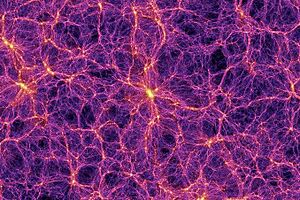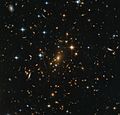Large-scale structure of the Universe facts for kids
The large-scale structure of the Universe describes how galaxies and matter are arranged in huge patterns. These patterns are much bigger than single galaxies or groups of galaxies. You can see these structures stretching for billions of light-years. They are shaped by the force of gravity.
On these very large scales, the Universe looks like a giant, connected web. Galaxies are found in groups and clusters. These groups are often located where long filaments of galaxies cross paths. These filaments can be more than 10 million light-years long. In between these structures are huge, mostly empty areas called voids. Voids contain very few galaxies.
Gravity plays a huge role in forming these structures. It pulls dark matter together into bigger and bigger clumps. Inside these clumps, ordinary gases cool down and condense. This process eventually leads to the formation of galaxies.
Contents
The Cosmic Web
The way galaxies are spread out in the Universe looks a lot like a giant spider web. Scientists call this the "cosmic web." This web is made of long strands of galaxies (the filaments) and large empty bubbles (the voids).
Filaments and Voids
Think of the Universe as a giant sponge. The parts where the sponge material is thickest are like the galaxy filaments. These are long, thin structures where many galaxies are found. They connect different galaxy clusters.
The holes in the sponge are like the voids. These are vast, empty spaces in the Universe. They have very few galaxies, or sometimes none at all. Voids can be hundreds of millions of light-years across.
Galaxy Clusters
At the points where the filaments meet, you often find galaxy clusters. These are huge collections of hundreds or even thousands of galaxies. They are the biggest known structures in the Universe held together by gravity. Our own Milky Way galaxy is part of a smaller group of galaxies. This group is called the Local Group. The Local Group is part of an even larger structure called the Virgo Supercluster.
How Structures Form
The Universe started out very smooth after the Big Bang. But there were tiny differences in how matter was spread out. Some areas had a little more matter than others.
The Role of Gravity
Over billions of years, gravity slowly pulled matter towards these slightly denser areas. This process caused the small differences to grow. More and more matter gathered together. This is how the first stars and galaxies began to form.
Dark Matter's Influence
Scientists believe that dark matter played a crucial role in forming these structures. Dark matter is a mysterious substance that we cannot see. However, it has gravity. It doesn't interact with light, but its gravity pulls ordinary matter together. Without dark matter, the structures we see today might not have formed. Dark matter created a kind of "scaffolding" for galaxies to build upon.
Studying the Universe's Structure
Scientists use powerful telescopes to map the Universe. They look at the light from millions of galaxies. By measuring how far away these galaxies are, they can create 3D maps of the cosmic web.
Redshift Surveys
One important tool is called a "redshift survey." When light from distant galaxies travels towards us, it gets stretched out. This stretching makes the light appear redder. The more "redshifted" the light is, the farther away the galaxy is. By measuring the redshift of many galaxies, astronomers can figure out their distances. This helps them build a picture of the Universe's large-scale structure.
Computer Simulations
Scientists also use powerful computers to simulate how the Universe evolved. These simulations start with the early Universe. They then apply the laws of physics, including gravity and the effects of dark matter. These simulations help scientists understand how the cosmic web grew over billions of years. They also help predict what the Universe should look like today.
Images for kids
-
Hubble Ultra-Deep Field image of a region of the observable universe (equivalent sky area size shown in bottom left corner), near the constellation Fornax. Each spot is a galaxy, consisting of billions of stars. The light from the smallest, most redshifted galaxies originated nearly 14 billion years ago.
-
Computer simulated image of an area of space more than 50 million light-years across, presenting a possible large-scale distribution of light sources in the universe—precise relative contributions of galaxies and quasars are unclear.
-
Panoramic view of the entire near-infrared sky reveals the distribution of galaxies beyond the Milky Way. The image is derived from the 2MASS Extended Source Catalog (XSC)—more than 1.5 million galaxies, and the Point Source Catalog (PSC)—nearly 0.5 billion Milky Way stars. The galaxies are color-coded by 'redshift' obtained from the UGC, CfA, Tully NBGC, LCRS, 2dF, 6dFGS, and SDSS surveys (and from various observations compiled by the NASA Extragalactic Database), or photo-metrically deduced from the K band (2.2 μm). Blue are the nearest sources (z < 0.01); green are at moderate distances (0.01 < z < 0.04) and red are the most distant sources that 2MASS resolves (0.04 < z < 0.1). The map is projected with an equal area Aitoff in the Galactic system (Milky Way at center).
See also
 In Spanish: Estructura del universo a gran escala para niños
In Spanish: Estructura del universo a gran escala para niños








